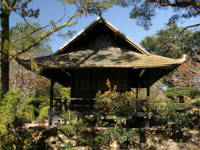
County Kildare
Kildare is an inland county located in the eastern part of Ireland. Bordering Dublin and Wicklow to the west, it is situated on the edge of the central plain. The county's main features are vast grasslands and lush, green pastures, which is why it has become home to many training yards and studs and is famous worldwide for its horse racing. Most of the major flat races, including the Irish Derby, take place at the Curragh Racecourse, just east of Kildare town. The other two courses of national importance located in the county are Punchestown Racecourse and Naas Racecourse. Irish National Stud, located in Tully, is open for visitors. In addition to the stables, you can visit The Irish Racehorse Experience, which tells the history of Irish horse racing, or the stunning Japanese Gardens. The north of County Kildare is a peatland which covers 243 square kilometers, 14 percent of its area. It is part of the Bog of Allen, extending almost 1000 square kilometers of central Ireland. Boglands are a very valuable source for the archaeological record. Due to its special preservation conditions, many kinds of artifacts survived in the peat, these include wooden structures and objects. All interesting information about peatlands can be found in the Bog of Allen Nature Centre. Another important feature of County Kildare is the Grand Canal. It was completed in 1803 and connected Dublin with the River Shannon. Until 1960 it served as a commercial trail for cargo barges. Now it is an important tourist attraction. Cruisers, barges, boats, and kayaks can be rented from the local providers along the route. The Grand Canal is also a well-known angling destination. County Kildare is also closely associated with St Bridgit (also called Brigid of Kildare or Brigid of Ireland), one of the three Irish national saints, along with St Patrick and St Columba. In the 5th century, she founded an abbey in Kildare, as well as several other convents of nuns. Now, on the site of the former monastery stands the restored 13th-century Kildare Cathedral. County Kildare is also home to many interesting historical attractions such as Castletown House or Ireland's tallest menhir, Punchestown Standing Stone. There are notable high crosses like Moone High Crosses and Castledermot High Crosses, or round towers like Old Kilcullen Round Tower, Taghadoe Round Tower, and Oughterard Round Tower.
Interesting places in county Kildare

Irish National Stud and Japanese Gardens
East Ireland | County Kildare
Irish National Stud and Japanese Gardens are located in Tully, County Kildare. The stud, which is a Thoroughbred horse breeding facility, is open for visitors and together with The Irish Racehorse Experience takes you to a journey through the world of horses and riding. Colonel William Hall-Walker established this stud in 1900, and in the 1940s it was given ... more info and photos

Castletown House
East Ireland | County Kildare
Castletown House is a Palladian-style mansion located in Celbridge, County Kildare. It was built by William Conolly, a Speaker of the Irish Parliament and one of the wealthiest people in Ireland at that time. Construction began in 1722, and most of the work was completed by 1729. It was the first Irish Palladian house built to correct Classical proportions, ... more info and photos



















